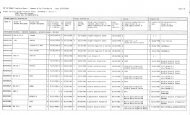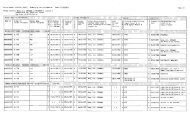Meet Mr. Porpoise - Ceta-Base
Meet Mr. Porpoise - Ceta-Base
Meet Mr. Porpoise - Ceta-Base
Create successful ePaper yourself
Turn your PDF publications into a flip-book with our unique Google optimized e-Paper software.
gether as it exists in the open sea. We therefore find<br />
in one tank sharks swimming side by side with a school<br />
of jacks, and a six-foot green moray coiled under the<br />
same rock that is home to a six-inch angel fish.<br />
Assume for a moment that we are guests for the<br />
day at Marineland. As we approach the giant tanks,<br />
we are astounded at the natural beauty of the place.<br />
The tanks themselves are built along the ocean front<br />
and to the east extends the broad expanse of the blue<br />
Atlantic. To the west the ground rises in lump contours<br />
of sand dunes and shell mounds, and rolls away<br />
to the Intra-Coastal Waterway shimmering in the<br />
bright Florida sunlight. Countless palms wave a<br />
friendly greeting and the white of the sand dunes is<br />
softened by cactus, yucca and seagrape.<br />
We approach the south end of the gigantic tanks<br />
and are directed to the main entrance. As we step<br />
into the lower corridor, soft blue lights lead us from<br />
porthole to porthole ; and through these windows we<br />
gaze in awe at the fascinating, colorful undersea<br />
world. The blue-green waters, pumped from the<br />
ocean at the rate of five million gallons per day, are<br />
iridescent and clear. The floor of the mammoth ocean-<br />
arium is covered with sand, sea shells and plumes.<br />
A seven-ton coral reef affords protection for the smaller<br />
specimens. A 300-pound turtle lumbers lazily over<br />
the coral reef, and great schools of shiny bumper fish<br />
follow in his path with the hopeful expectancy of find-<br />
ing a few scraps of food the big fellow might leave<br />
behind. From the stern of a shipwreck, the long<br />
sinewy shape of a shark electrifies the scene, and many<br />
of the smaller fish scuttle for cover. A huge ray gro-<br />
tesquely flaps his way over the sea fans while a spotted<br />
moray suspiciously eyes his passage from a safe sanctum<br />
in the coral.<br />
The 200 glass portholes, averaging 18 x 24 inches,<br />
encased in the steel tank walls, stand out like brightly<br />
lighted stages in the semi-dark corridors. Sitting in<br />
front of a porthole, the visitor is shielded from in-<br />
clement weather and outside distractions as the immense<br />
life of the ocean floor unfolds before him.<br />
In their large size also, the oceanariums are unique.<br />
The circular tank, the one in which the porpoises live,<br />
is 75 feet in diameter and twelve feet deep. The other<br />
is roughly rectangular and has a length of 100 feet,<br />
width of 40 feet and a maximum depth of 18 feet.<br />
Connecting the two, and serving as a quarantine for<br />
new specimens, is the shallow receiving tank.<br />
The design of this structure was conditioned by<br />
the three functions it was to perform. First, to offer<br />
the public the opportunity to observe the complexities<br />
of life under the surface of the sea. Second, to offer<br />
the motion picture industry the facilities for filming<br />
underwater action against an authentic background.<br />
Third, and most significant, to offer the scientific<br />
world the opportunity for study and investigation into<br />
the biological problems for which the facilities of the<br />
institution are most adequately fitted.<br />
To the visitors at Marine Studios, the bottle-nosed<br />
dolphin, commonly known as porpoise in American<br />
waters, is of greatest interest. The first view of the<br />
large gray animals, from underwater, completely<br />
transforms previous concepts of them.<br />
Battleship gray with its underbody a dull white,<br />
the porpoise embodies Nature's most streamlining<br />
effects. Observing them through the portholes, the<br />
visitor is amazed at the grace and speed which the<br />
porpoise attains. The tail of the porpoise, unlike that<br />
of any fish, beats up and down and by this perpendicu-<br />
lar motion, the supple flow of muscular effort through-<br />
out the entire body enables the porpoise to attain tremendous<br />
bursts of speed. Frequently after the animal<br />
has achieved momentum he will arch his back and<br />
glide across the tank; and often during courtship, the<br />
animal will barrel roll for some 20 to 30 feet.<br />
<strong>Porpoise</strong>s, of course, are primarily fish eaters, and<br />
in coastal Florida waters they feed principally on<br />
mullet. This readily obtained fish is fed to the porpoises<br />
here, and each adult eats at least 20 pounds<br />
daily.<br />
Two opportunities, to date, have been offered to<br />
observe the nursing and weaning of a young porpoise.<br />
The two originally captured in March, 1938, proved<br />
to be mother and daughter ; the young one beginning<br />
to nurse at once. Throughout the day and night the<br />
baby took nourishment at 15 to 30 minute intervals.<br />
When nursing, the young porpoise holds the end<br />
of its snout for about five seconds over the inverted<br />
nipple, which lies hidden in a fold in the blubber. By<br />
contraction of specialized muscles of the abdomen the<br />
parent forces the milk, which has collected in sinuses<br />
running lengthwise through the mammary tissue, into<br />
the mouth of the offspring. The whole operation can<br />
take place quickly, an obvious necessity, because young<br />
porpoises very rarely remain submerged, at least here<br />
in the oceanariums, for more than 30 seconds. Young<br />
nursing manatees, on the other hand, remain underwater<br />
for ten minutes and suckle in typical mammalian<br />
manner.<br />
Three weeks after capture, the young one began<br />
grasping fish in her mouth, and after playing with the<br />
fish for a few moments would drop it and pick up another.<br />
Once in the fourth week the young one was<br />
observed to swallow at least one fish.<br />
The following day the baby was in distress. The<br />
dull eyes and listless form bespoke complete misery.<br />
Frequently the young porpoise vomited, and each time<br />
the attendant parent rubbed the stomach of the little<br />
one steadily with her snout. By late afternoon the at-<br />
tack passed, leaving the young one completely fatigued.<br />
18 NATURAL HISTORY, JANUARY, 1940











